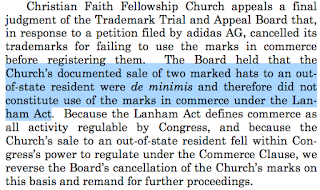CBM(Covered Business Method review)為一種AIA法案實施後的異議制度之一,相關簡介如:http://enpan.blogspot.tw/2012/10/aia.html。
CBM雖名為針對"business method",但其實不容易簡單判斷某個專利是否涉及"business method",根據USPTO資料,設計CBM時,規範其適用「執行金融商品或服務的資料處理或運作的方法與相關裝置」上,雖好像很清楚,但仍可能對CBM適用範圍留下了一個"模糊地帶":"資料處理"。
提出CBM的條件:(1)專利公告後9個月(這是PGR適用期間)以後;(2)提出CBM者需要涉及侵權訴訟;(3)CBM請求者應證明系爭專利適用CBM(CBM patent);(4)"first-to-invent"時期的專利的前案引用仍應符合AIA前規定。

CBM程序適用執行"金融商品或服務"的資料處理或運作的方法或裝置。

如果專利引用新穎與非顯而易見的技術特徵,以及用技術方案解決技術問題,具有可專利標的。

適用CBM程序的對象為符合CBM條件的專利(CBM patent)、請願人需要涉及侵權訴訟(IPR, PGR沒有此條件)、專利不是技術性發明(不可專利性)。

查一下過去討論過的CBM(Covered Business Method)案,例如:
- 第一件CBM案例討論以及裁決(CBM2012-00001)(http://enpan.blogspot.tw/2014/05/cbmcbm2012-00001.html)
- 說明書的金融相關描述會影響請求項是否為商業方法的判斷 - CBM2015-00004(http://enpan.blogspot.tw/2016/04/cbm2015-00004.html)
- CBM案例討論(CRS v. Frontline,發明為人力資源管理的技術)(http://enpan.blogspot.tw/2014/02/cbmcrs-v-frontline.html)
- Enfish案影響電腦相關技術可專利性的案例 - CBM2016-00019(http://enpan.blogspot.tw/2016/05/enfish-cbm2016-00019.html)
本次討論案例Unwired Planet v. Google (Fed. Cir. 2016)就是討論CBM的適用範圍,法院作出了指示。
案例資訊:
上訴人/原專利權人:UNWIRED PLANET, LLC
被上訴人:GOOGLE INC.
系爭專利:US7,203,752
CBM2014-00006資訊:
啟始的異議理由:
系爭專利US7,203,752關於管理行動裝置地理位置可否存取的方法。
Claim 25界定控制存取無線通訊裝置的地理資訊的方法,先接收取得地理資訊的請求,並取出用戶檔案,其中有授權名單,藉此判斷是否請求客戶有被授權,若為非授權對象,即否決請求。
25. A method of controlling access to location information for wireless communications devices operating in a wireless communications network, the method comprising:
receiving a request from a client application for location information for a wireless device;
retrieving a subscriber profile from a memory, the subscriber profile including a list of authorized client applications and a permission set for each of the authorized client applications, wherein the permission set includes at least one of a spatial limitation on access to the location information or a temporal limitation on access to the location information;
querying the subscribe profile to determine whether the client application is an authorized client application;
querying the subscriber profile to determine whether the permission set for the client application authorizes the client application to receive the location information for the wireless device;
determining that the client application is either not an authorized client application or not authorized to receive the location information; and
denying the client application access to the location information.
判斷系爭專利發明是否符合101規定,自然是依據最高法院的意見:
在TWO-STEP TEST中,「使用用戶檔案控制地理資訊存取權限」的發明被認定為抽象概念,也就是這是一種人類活動管理(organizing human activity),也沒有改善任何技術。接著分析是否發明中有任何元件可以轉換發明為可專利標的?也就是請求項發明是否可以"實質超越"抽象概念?PTAB認為,請求項發明中盡是已知程序與習知的活動,其中硬體也非進步到可以轉換抽象概念為可專利的發明。(這部分往往需要引證文件佐證發明中沒有新穎或進步的技術,本案在沒有引證下也能知道請求項中僅使用了一般常見的裝置與環境)
PTAB決定:
PTAB同意異議人提出系爭專利Claims 25-298發明為違反35USC101的不可專利標的。
關於系爭專利是否適用CBM,PTAB作出以下判斷:
"The Board based its review on “whether the patent claims activities that are financial in nature, incidental to a financial activity, or complementary to a financial activity.”"
這裡提到"incidental to"以及"complementary"都是讓金融相關發明可以擴及到很廣的範疇去。想要取得專利的電腦技術應該都可能被涵蓋進去。
PTAB認為,系爭專利中的用戶端應用可能是服務或商品供應商,供應商需要知道手機的地理位置而提供關聯廣告,是一種金融服務或商品的附帶技術,因此認為符合CBM定義(我想過去很多案涉及電腦技術的CBM也是這樣考量吧!)。

Google主張,系爭專利說明書提到這個技術可以用在適地性廣告上,已經符合CBM的適用範圍,PTAB也認為技術最終是用在服務銷售,是一種CBM適用的專利。
對於USPTO怎麼解釋,涉及國會討論CBM法規的用語,認為討論CBM的立法意圖(legislative intent)時,還包括了法律背後的歷史脈絡,認為CBM涵蓋了金融服務的附帶技術,而不僅是商業方法本身。

CAFC依據AIA § 18(d)規定反駁說,用了很極端的例子,一個裝在銀行的燈泡專利不會變成是銀行使用符合CBM的附帶專利(CBM patent),又,一個挖溝工具不會因為販售了所挖出的污垢而變成CBM專利。因為這些東西並非涉及"direct to"執行金融相關的資料處理與運作的方法或商品。


CAFC法官認為PTAB錯誤定義CBM,撤回PTAB對於CBM2014-00006的決定。

這裡提到"incidental to"以及"complementary"都是讓金融相關發明可以擴及到很廣的範疇去。想要取得專利的電腦技術應該都可能被涵蓋進去。
PTAB認為,系爭專利中的用戶端應用可能是服務或商品供應商,供應商需要知道手機的地理位置而提供關聯廣告,是一種金融服務或商品的附帶技術,因此認為符合CBM定義(我想過去很多案涉及電腦技術的CBM也是這樣考量吧!)。

Google主張,系爭專利說明書提到這個技術可以用在適地性廣告上,已經符合CBM的適用範圍,PTAB也認為技術最終是用在服務銷售,是一種CBM適用的專利。
對於USPTO怎麼解釋,涉及國會討論CBM法規的用語,認為討論CBM的立法意圖(legislative intent)時,還包括了法律背後的歷史脈絡,認為CBM涵蓋了金融服務的附帶技術,而不僅是商業方法本身。

CAFC階段:
系爭專利claims 25-29經PTAB判定無效後,Unwired上訴。將CBM適用提昇成為主要上訴議題是上訴人很厲害的策略。
CAFC將議題專注在系爭專利是否屬於CBM適用的專利(CBM patent),認為PTAB將CBM涵蓋範圍解釋錯誤,至少AIA規範下的CBM並沒有用到「"incidental to"、"complementary」兩個用語。CAFC依據AIA § 18(d)規定反駁說,用了很極端的例子,一個裝在銀行的燈泡專利不會變成是銀行使用符合CBM的附帶專利(CBM patent),又,一個挖溝工具不會因為販售了所挖出的污垢而變成CBM專利。因為這些東西並非涉及"direct to"執行金融相關的資料處理與運作的方法或商品。


CAFC法官認為PTAB錯誤定義CBM,撤回PTAB對於CBM2014-00006的決定。

my two cents:
原本想要講,要不然就去提個IPR(議題限定在102, 103),其實,不用我們提醒,Google也已經提出IPR(IPR2014-00037),也已經在2015/4/6作出最終決定。
IPR決定是Claim 25不具新穎性:
"This is a Final Written Decision under 35 U.S.C. §318(a). Based on the record presented, we are persuaded that Petitioner has shown by a preponderance of the evidence that claim 25 of the ’752 patent isanticipated by Havinis ’102."
本次CAFC意見十分限縮CBM的適用範圍,也十分重要(雖也可能被推翻),因為在AIA幾種異議程序中,PGR時間限制在9個月新公告的專利上,其他能夠討論101議題的只有CBM,如果這回確認CBM僅適用「金融服務與商品」,這樣電腦技術方面似乎可以喘一口氣,而軟體發明的101議題(除了ex parte reexamination)大概都只能在法院上討論了!
不過,某個電腦技術是否是金融相關技術,這也是有得爭了。
判決文:
http://www.cafc.uscourts.gov/sites/default/files/opinions-orders/15-1812.Opinion.11-17-2016.1.PDF
(備份:https://app.box.com/s/4dhb10kgipn9t9wbjkg2dpaezio3jun4)
CBM2014-00006決定:
https://app.box.com/s/tooixottdj82pf82tebakg1hiwkpua3s
資料參考:
http://patentlyo.com/patent/2016/11/business-financial-products.html
參考資料:
https://www.uspto.gov/sites/default/files/aia_implementation/20110916-pub-l112-29.pdf
America Invents Act 18(a)(1)(C)
SEC. 18. TRANSITIONAL PROGRAM FOR COVERED BUSINESS METHOD PATENTS.
(C) A petitioner in a transitional proceeding who challenges the validity of 1 or more claims in a covered business method patent on a ground raised under section 102 or 103 of title 35, United States Code, as in effect on the day before the effective date set forth in section 3(n)(1), may support such ground only on the basis of—
(i) prior art that is described by section 102(a) of such title of such title (as in effect on the day before such effective date); or
(ii) prior art that— (I) discloses the invention more than 1 year before the date of the application for patent in the United States; and (II) would be described by section 102(a) of such title (as in effect on the day before the effective date set forth in section 3(n)(1)) if the disclosure had been made by another before the invention thereof by the applicant for patent.
感謝3S-IP朋友告知。
Ron




































